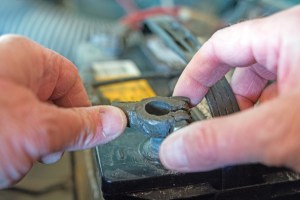
Understanding heavy duty truck batteries
Truck batteries are primarily responsible for powering the starting system, but they also supply energy to all electrical components. When they aren’t operating correctly, everything from cab light outages to complete system failure can occur. It’s important to maintain battery health in each vehicle to keep your fleet running efficiently.
What causes battery failure?
The top three reasons for failure are improper charging, vibration and using the wrong battery. Reduce the risk of breakdowns by understanding these issues and taking measures to avoid them.
Improper charging
Are your truck batteries not maintaining their charge? Explore these common causes and quick solutions:
Loose cables
If the cables aren’t securely attached to the battery terminals, the vehicle will most likely have issues starting. Keeping the connection tight will ensure the charge is going where it needs to, resulting in improved performance.
Corrosion
Corrosion occurs when battery terminals are exposed to the hydrogen gas found in battery acid. Because corrosion can lead to undercharging, terminals should be visually inspected and cleaned at regular intervals to remove any build-up. Keep in mind that frequently recurring corrosion is a sign of a problem with the terminals and should be looked into further.
Parasitic loads
Parasitic loads draw energy from the batteries that the vehicle can’t replace — usually because it’s turned off or idling. Common culprits are devices such as radios and “hotel loads” like microwaves and televisions, but any excessive use can be the cause. Left uncontrolled, parasitic loads can deeply discharge batteries and prevent trucks from starting. Testing can confirm the presence of a parasitic load so technicians can locate the source and resolve the issue.
Reduced alternator output
A discharged battery could indicate trouble with the alternator. Always check voltage and current output from the alternator to be sure OEM specifications are met for charging output. This should always be done during routine battery maintenance or when batteries are replaced.
Vibration
Avoid damage to terminals, casing and plate assemblies by properly securing batteries. Examine the tie-downs to ensure they haven’t broken or loosened, and confirm the stability of each battery by attempting to shift them.
Incorrect type
There are several ways to choose a battery, but the main things to consider are type and rating. Most fleets will use either Absorbed Glass Mat (AGM) or flooded cell batteries in their trucks, and each type has unique specifications to consider. AGMs are believed to cycle better and last longer than flooded cell batteries, but not all fleets believe they are worth the cost of upgrading. Ratings are set using multiple parameters, including reserve capacity (RC) — the ability to store power — and cold cranking amps (CCA) — the amount of current that can be delivered. A high CCA is ideal for vehicles that need a lot of energy to start, and a larger reserve capacity is good for vehicles that require long-lasting power.
While determining the best battery requires a close look at your electrical profile, there are indicators that you’re using the wrong one. Signs include:
- The need for frequent jumpstarts with regular use of the electrical system
- Difficulty starting in average cold weather conditions
- Batteries aren’t recharging during normal driving routes
If you suspect incorrect batteries are installed, consult a trained technician to determine the best type for your application.
When do they need to be replaced?
The importance of uptime may lead fleets to replace batteries more frequently than needed. While keeping trucks on the road should be a priority, it’s beneficial to look at the vehicle as a whole before making decisions about the equipment. Otherwise, you may replace batteries that were discharged due to a bigger problem — leading to unnecessary costs that don’t solve the root issue.
Performing load tests, voltage drop tests and other circuit checks will help identify the source of your electrical problems. Once you’ve determined the battery is at fault, you can replace it and know the vehicle is ready to use. It’s important to note that technicians should always be properly trained before handling testing equipment. If the devices aren’t calibrated correctly or aren’t in the proper setting, they may produce inaccurate readings and lead you to pull batteries that are still functional.
Note: Always perform load tests on each battery by disconnecting all cables.
Address truck battery problems with routine service
Don’t waste time and money dealing with dead batteries — establish a preventive maintenance (PM) program through FleetNet America® to keep your vehicles in peak operating condition. FleetNet will:
- Keep track of warranties
- Schedule vehicle and battery maintenance
- Look for repair patterns that signify a larger problem
- Help you save money by avoiding unnecessary replacements
- Catch minor issues before they lead to breakdowns
For more information about establishing a PM program to help maintain truck batteries, call 855-836-3912.
